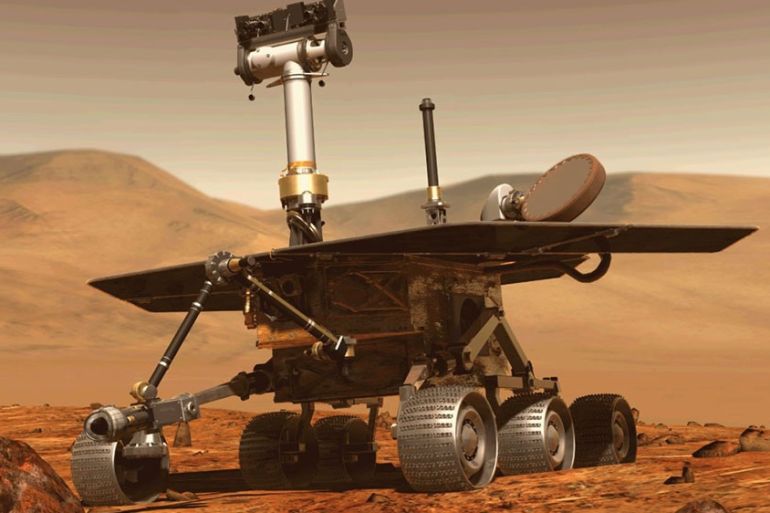Mission complete: NASA announces demise of Opportunity rover
Researchers and engineers involved are in mourning over the passing of the NASA rover, known affectionately as Oppy.

During 14 years of intrepid exploration across Mars, it advanced human knowledge by confirming that water once flowed on the Red Planet – but NASA’s Opportunity rover has analysed its last soil sample.
The robot has been missing since the US space agency lost contact with it during a dust storm in June last year and was declared officially dead on Wednesday, ending one of the most fruitful missions in the history of space exploration.
Keep reading
list of 4 itemsNorthern lights dazzle skygazers as ‘extreme’ solar storm hits Earth
Boeing postpones launch of Starliner space capsule after technical fault
China launches Chang’e-6 probe to study dark side of the moon
Unable to recharge its batteries, Opportunity left hundreds of messages from Earth unanswered over the months, and NASA said it had made its last attempt at contact.
“I declare the Opportunity mission as complete,” Thomas Zurbuchen, associate administrator of NASA’s Science Mission Directorate told a news conference at mission headquarters in Pasadena, California.
The community of researchers and engineers involved in the programme were in mourning over the passing of the rover, known affectionately as Oppy.
“Spent the evening at JPL as the last ever commands were sent to the Opportunity rover on #Mars,” Tanya Harrison, director of Martian research at Arizona State University, tweeted after a stint at Pasadena’s Jet Propulsion Laboratory.
“There was silence. There were tears. There were hugs. There were memories and laughs shared. #ThankYouOppy #GoodnightOppy,” she wrote.
|
|
Extraordinary success
The nostalgia extended across the generations of scientists who have handled the plucky little adventurer.
“Godspeed, Opportunity,” tweeted Keri Bean, who had the “privilege” of sending the final message to the robot.
“Hail to the Queen of Mars,” added Mike Seibert, Opportunity’s former flight director and rover driver, in another tweet while Frank Hartman, who piloted Oppy, said he felt “greatly honoured to have been a small part of it”.
“Engulfed by a giant planet-encircling dust storm: Is there a more fitting end for a mission as perfect and courageous from start to finish as Opportunity?” he said.
The programme has had an extraordinary record of success: 28.1 miles (45.2 kilometres) traversed, more than the Soviet Union’s Lunokhod 2 moon rover during the 1970s and more than the rover that US astronauts took to the moon on the Apollo 17 mission in 1972.
Opportunity sent back 217,594 images from Mars, all of which were made available on the internet.
“For the public, the big change was that Mars became a dynamic place, and it was a place that you could explore every day,” Emily Lakdawalla, an expert on space exploration and senior editor at The Planetary Society.
“The fact that this rover was so mobile, it seemed like an animate creature,” she said. “Plus it has this perspective on the Martian surface that’s very human-like.”
“It really felt like an avatar for humanity travelling across the surface,” she added.
Opportunity landed on an immense plain and spent half its life there, traversing flat expanses and once getting stuck in a sand dune for several weeks. It was there, using geological instruments, that it confirmed that water was once present on Mars.
During the second part of its life on Mars, Opportunity climbed to the edge of the crater Endeavour, taking spectacular panoramic images – and discovering veins of gypsum, additional proof that water once flowed among the Martian rocks.
Opportunity’s twin, Spirit, landed three weeks ahead of it and was active until it expired in 2010. The two far exceeded the goals of their creators: In theory, their missions were supposed to last 90 days.
Today, only a single rover is still active on Mars, Curiosity, which arrived in 2012.